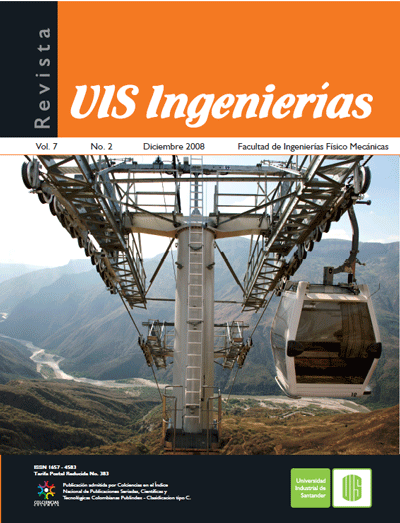Strategies for the calculation of heat exchangers through the method of finite volumes. Part 1: development of formulation
Published 2008-12-03
Keywords
- Heat Exchanger,
- Finite Volume Method,
- Numerical Method,
- Heat Transfer,
- Fluid mechanics
How to Cite
Abstract
This research work shows different numerical schemes for 1D flow heat exchanger calculations based on Finite Volume Methods (FVM). The method allows calculating heat exchanger, flows in pipes, among other, where besides to appear pressure drops due to the flow field, a heat transfer can be presented with the environment, or another fluid. The general proposed method uses energy conservation, momentum conservation and mass conservation equations. Such equations are integrated throughout the heat exchanger, that along with the equations of state, and the equations that allow evaluating certain empirical parameters, constituting a system of nonlinear equations to solve. This paper describes a comparison of time consumption where sequential and simultaneous heat exchanger calculations are performed. The results show the most convenient calculation method obtained in this study that present the lowest error and time consumption is the sequential method when a constant wall temperature is assumed.
Downloads
References
Ranganayakulu Ch., et. al, “The effects of longitudinal conduction in compact plate-fn and tube-fn heat exchangers using a fnite-element method,” Int. J. Heat and Mass Transfer, vol. 40, pp. 1261–1277, 1997.
Chiou J.P., “The advancement of compact heat exchanger theory considering the effects of longitudinal heat conduction and flow nonuniformity,” Symp. Compact Heat ExchangersHistory, ASME, pp. 101–105, 1980.
Ranganayakulu Ch., et. al, “The effects of inlet fluid flow nonuniformity on thermal performance and pressure drops in crossflow plate-fn heat exchangers,” Int. J. Heat and Mass Transfer, vol.40, pp. 27–38, 1997.
Corberán J.M., et al, “Semiexplicit method for wall temperature linked equations (SEWTLE): A general fnite-volume technique for the calculation of complex heat exchangers,” Numerical Heat Transfer, vol. 40, pp. 37–59, 2001.
García-Valladares O, et al, “Numerical simulation of double-pipe condenser and evaporators,” International Journal of Refrigeration, vol. 27, pp. 656–670, 2004.
Paffenbarger J., Compact Heat Exchangers. Hemisphere, Washington DC, 1990, ch. General Computer Analysis of Multistream, Plate-Fin Heat Exchangers.
Kuppan T., Heat Exchanger Desing Handbook. New York: Marcel Dekker Inc., 2000.
Patankar, S.V., Numerical Heat Transfer and Fluid Flow. Hemisphere, 1980.
García-Valladares O, et al, “Numerical simulation of triple concentric tube heat exchangers,” International Journal of Thermal Sciences, vol. 43, pp. 979–991, 2004.
Ünal Ahmet, “Theorical analisys of triple concentric tube heat exchanger part 2: Case studies,” Int. Comm. Heat and Mass Transfer, vol. 28, pp. 243–256, 2001.
Navarro H., Cabezas-Gómez L., “A new approach for thermal performance calculation of cross-flow heat exchangers,” Int. J. of Heat and Mass Transfer, vol. 48, pp. 3880–3888, 2005.
Ribeiro C.P., Caño M.H., “An algorithm for steady-state simulation of plate heat exchangers,” Journal
of Food Engineering, vol. 53, pp. 59–66, 2002.
Browne M.W., Bansal P.K., “An elemental NTU-ε model for vapour compression liquid chillers,” International Journal of Refrigeration, vol. 24, pp. 612–627, 2001.
Gut J., Pinto J., “Modeling of plate heat exchangers with generalized confgurations,” Int. J. Heat and Mass Transfer, vol. 46, pp. 2571–2585, 2003.
Lee J.H., et. al, “Experimental and numerical research on condenser performance for r-22 and r-407c refrigerants,” International Journal of Refrigeration, vol. 25, pp. 372–382, 2002.
Kuo M.C., “An algorithm for simulationn of the performance of aircooled heat exchanger applications subject to the influence of complex circuitry,” Applied Thermal Engineering, vol. 26, pp. 1–9, 2006.
M.W. Versteeg H.K., An Introduction to Computational Fluid Dynamics.The Finite Volume Method. Longman house, Burnt Hill, Harlow, Essex CM20 2JE, England: Longman Scientifc & Technical, 1995.
Harvey A.H., Peskin A.P., Klein S.A., “NIST/ ASME steam properties. Formulation for general and scientifc use. NIST standard reference database 10 - version 2.11,” 1996.

